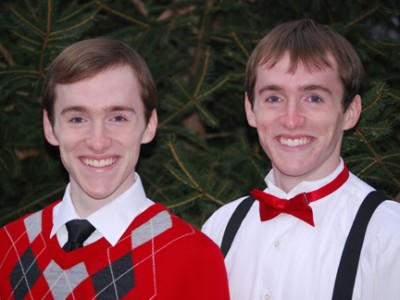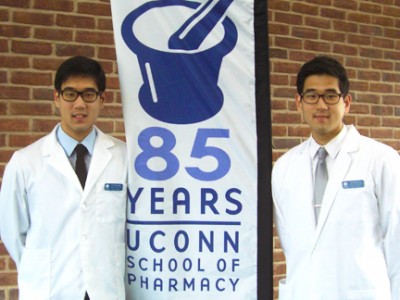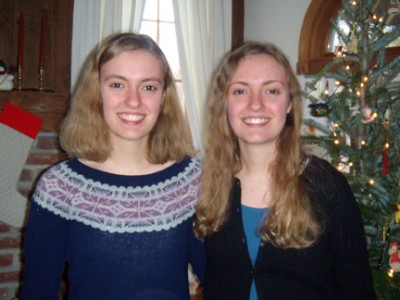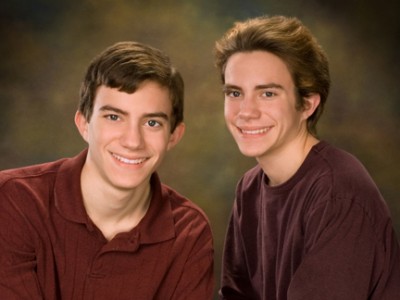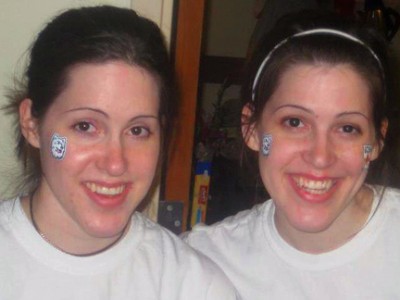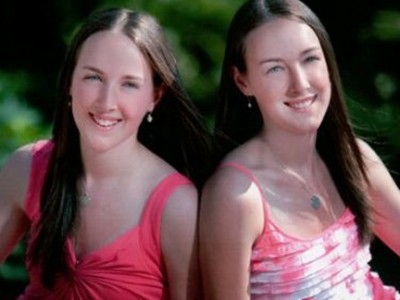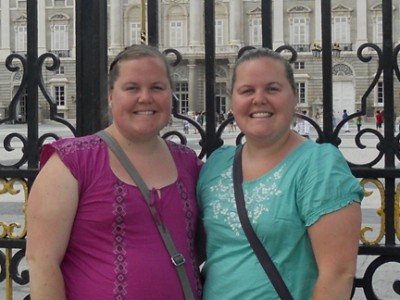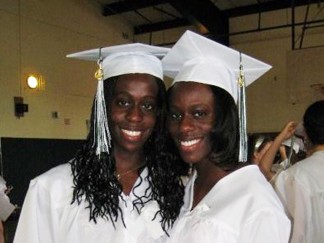By Cheryl Cranick, Honors Program
Currently in the UConn Honors Program, of the roughly 1,600 students enrolled or who have just graduated, 22 do not just have a sibling on campus; they have a physical double. In 2011-2012, the Honors Program included eleven sets of identical twins. The presence of identical twins is not unusual for the Honors Program, which has had twins in previous graduating years.
The National Institutes of Health cites there are roughly four to six million twins living in the United States, and according to the 1990 U.S. Census, the live birth rate of twins was 22.6 percent of the overall children born. Neither source delineates whether the twins are identical or fraternal. U.S. birth certificates do not record such specific data. In fact, not all of the twin siblings in Honors know for certain that they are genetically identical.
“We would have to do blood tests to find out, and our parents never really thought it mattered,” said Hannah Tripp ’15, sister of Elizabeth Tripp ’15. A recent study reported in the International Journal of Obstetrics and Gynecology notes that physicians are sometimes wrong when determining if twins are identical or fraternal. Doctors place great emphasis on the placenta—if there are two placentas, identical twins may be incorrectly identified as fraternal. However, if a single egg splits within the first few days of fertilization, individual placentas can form for identical siblings, causing the doctor to assume the children each began from separate eggs.
Brittany Jasperse ’12 and Lindsay Jasperse ’12 have been told they are fraternal twins, despite looking remarkably similar. Kaitlyn Carroll ’15 and Alexandra Carroll ’15 do not have official confirmation either. “But since we look exactly alike, and were the same height and weight for years, I would say we’re most definitely identical,” said Kaitlyn Carroll.
Though the siblings may not all have conclusive results as to their genetics, they all share an experience unique to identical twins. “Those who do not know us well often cannot tell the difference between us,” said Stephanie DeMaio ’15. Her sister is Jessica DeMaio ’15. Reactions to being called the wrong name vary based on the person and the situation.
“How I handle these moments depends on who mistakes us,” said Rebecca Puelle ’13. “When our friends get us wrong, we immediately correct them because usually they just aren’t thinking; if someone we don’t know walks past us and waves or says hi, we’ll respond like we know them because it’s better to pretend to be the other twin than to ignore someone.” Her sister, Rachel Puelle ’13, agrees.
Kristyn Piotrowski ’14 finds such mistakes to be humorous and does not bother to correct the errors, “unless the conversation is longer, and then we have to fess up.” But her sister Catherine Piotrowski ’14 is much shyer. She has a tendency to feel nervous when strangers engage her in conversation, believing she is Kristyn.
Sometimes strangers do not realize the sibling is actually a twin, which can make for an awkward situation. Ju-Sung Song ’12, whose brother is Ju-Young Song ’12, often tries to put the person at ease. “People always apologize for their mistake, but it’s not their fault. I tell them it’s my fault to be a look-alike.”
Even close relatives accidentally mistake one sibling for another from time to time. “Sometimes we’ll ridicule people who shouldn’t be confusing us at this point—such as our mother—but it’s always in jest,” remarked Nick Wasko ’13, who is known for a shared sense of humor with his brother Chris Wasko ’13.
Mixing up siblings, or assuming they are a pair versus individual people, calls into question the concept of identity. “Sometimes I want to be recognized by myself, not as a twin. But most of the time we are just recognized by the ‘twin’,” said Ju-Sung Song. “Many of our friends would tell you that we are exactly the same, but this is not true at all,” said Rachel Puelle, whose sister is more outgoing, a stronger writer, and more inclined to wear bright colors.
But sometimes the identity confusion is fun. “[In elementary school,] our mom used to let us switch one day a year,” said Spencer Reese ’13, brother of Tyler Reese ’13, “as long as she knew which day it was. Some years we lasted as long as four or five hours in the opposite class before the teachers figured it out.” Catherine Piotrowski and Kristyn Piotrowski have done so as well. “We graduated for each other,” said Catherine Piotrowski. “I went up when they called [Kristyn’s] name and took her diploma, and she took mine…I told my mom beforehand what we were going to do, but she didn’t believe me and was shocked when we actually did.”
‘Born with a best friend’
Still, not one of the 22 reported wishing he or she had been a single birth. “It’s like being born with a best friend,” said Elizabeth Ojukwu ’12, sister to Mary Ojukwu ’12. “I definitely love being a twin, though I don’t know what it’s like not to be one,” said Lindsay Jasperse. “I don’t think people who don’t have a twin can fully appreciate the relationship that we have,” said Rachel Puelle. “I cannot imagine not having someone in my life who knows literally everything about me.”
With shared features and shared characteristics, it is not surprising that most of the siblings have shared interests. Only three of the eleven pairs are studying distinctly different fields. The rest are pursuing either the exact major or one almost the same as the other. The Wasko brothers and the Reese brothers are particularly unique. Nick Wasko is a scientist and Tyler Reese is a mathematician. Chris Wasko is a music education major and Spencer Reese is a music major.
For both the Wasko brothers and the Reese brothers, each sibling is proficient in the other’s field and is sometimes even a rival. “At the end of middle school,” said Spencer Reese, “they gave an award to the highest scoring math student in the entire school. I beat Tyler by .01 point and now my name is on a giant trophy in the library…For me, though, math was always a skill, but never a passion.”
However, even as the Ojukwu sisters are both aspiring physicians, they were in separate labs researching separate topics. The Casaly sisters were both in the anthropology department, but Paige Casaly ’12 plans to attend law school, while Allison Casaly ’12 wants to earn an advanced degree in archaeology.
In addition to the 22 identical twins in the Honors Program, there are other Honors students who are also identical twins, yet chose to attend college away from their siblings, reported Brittany Jasperse. But there was no agreement as to the likelihood of twins selecting the same university. The Wasko brothers preferred to be together, if they could find a college that matched both of their needs. Rachel Puelle and her sister Rebecca “…decided that we would pick the school we wanted to go to individually, and if it happened to be the same one, so be it.”
Many also roomed together once they arrived on campus. Hannah Tripp noted having her sister as her roommate during freshman year, “…kept me from feeling like I was totally alone.” But Spencer Reese and Tyler Reese, who had shared the high school graduation stage as co-valedictorians, specifically requested different rooms. “While we are certainly very close as brothers and cherish being twins, we did not want to be labeled as ‘The Twins,’ who only existed as the counterpart of the other,” said Tyler Reese.
The twins will always share a physical appearance, but something else they share is a childhood. Their close proximity during youth is what many attribute to those moments where it seems they could have a telepathic connection. “Sometimes we finish each other’s sentences,” said Elizabeth Ojukwu. “But I think that could happen with almost anyone who thinks alike.”
The Wasko brothers do not believe in superstition either, “but we do have an uncanny awareness,” said Nick Wasko. Chris Wasko agrees. “My mom’s favorite story is when she and my dad went to our preschool class; one sat with each of us opposite the other in a circle for an activity,” he said. “The game was that we had to reach into a brown paper bag, feel a toy—there were a handful in the bag—and guess what it was purely by touch. If we got it right, we got to keep the toy. One of us reached into the bag and felt a toy, and the other called out from across the room, ‘It’s a car!’ And it was.”
Return to the Spring 2012 issue of the Honors Alumni eNewsletter
